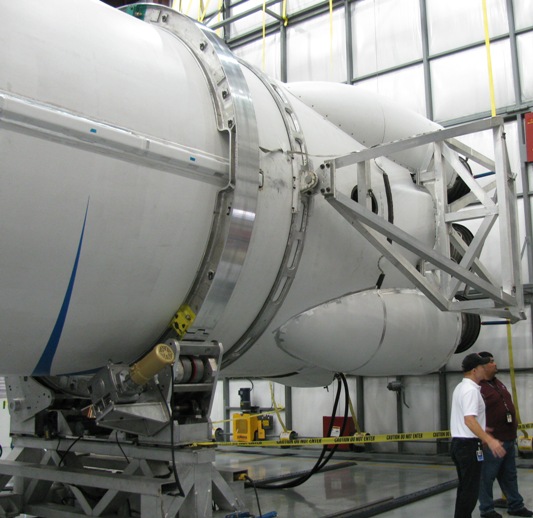Over a two day period last week, Space Exploration Technologies – better known as SpaceX (News - Alert) – wooed the media gathered at the Kennedy Space Center for the last launch of the space shuttle, STS-135 Atlantis. Several buses full of press got a tour of SpaceX's LC-40 launch site at Cape Canaveral Air Force Base, the company's launch control center (LCC), and a look at the flight-proven Dragon space capsule on July 6 and held a reception at the Air Force Space & Missile History Center – right behind its LCC – the following evening.
In common usage, most people tend to lump/confuse NASA Kennedy Space Center with Cape Canaveral Air Force Base – I mean, they are all in Florida, all along the "Space Coast" area, right? In practice, NASA has its own public/civilian plot for civilian launch operations that was carved out of/next to the Cape Canaveral Air Force Base, launch complex (LC) 39. NASA didn't start launching astronauts off of its own pads until Apollo 8, while the launch of unmanned science missions have continued from Cape Canaveral Air Force Base from the start of the space program to this day.
SpaceX's launch pad for the Falcon 9 and Dragon cargo missions is LC-40 – Air Force territory. The former Titan III and IV launch pad was licensed to SpaceX on a non-exclusive in 2007. SpaceX couldn't secure an exclusive lease because other launch providers started making noises about how they "might" need the pad in the future, so in theory others could use it.
 Once leased, SpaceX had to clean up the pad for use, building what one company official called a "glorified warehouse" to house the Falcon 9/Dragon combination before launch and buying an Apollo-era surplus 100,000 gallon liquid oxygen tank from NASA at one dollar above scrap value, then trucking it over to LC-40 to install and clean it up.
Once leased, SpaceX had to clean up the pad for use, building what one company official called a "glorified warehouse" to house the Falcon 9/Dragon combination before launch and buying an Apollo-era surplus 100,000 gallon liquid oxygen tank from NASA at one dollar above scrap value, then trucking it over to LC-40 to install and clean it up.
Falcon 9 stages are sized to be trucked across country from the SpaceX factory in LA to Florida. Once they arrive, they go into the warehouse to be assembled and prepped for launch, with first stage, second stage, and the payload all bolted on. Assembly is done horizontally, keeping down costs and complexity of having to work with everything vertically.
Assembled, the completed Falcon 9 is put onto a transporter/erector and simply dragged out of the hanger to the pad a couple hundred yards away by a mundane airport tug along a pair of rails left over from the Titan days.
Still horizontal, the Falcon 9 is rolled into place, then clamped on the pad and fueling connections are made. The 180 foot long, 17 feet in diameter rocket is then raised to vertical with a pair of massive hydraulic cylinders and fueling starts, with RP-1 and liquid oxygen pumped in.
SpaceX says from rollout through ready-to-launch currently takes six hours – but officials say they want to cut it down to an hour. Minimizing the time outside of the air conditioned hanger means less humidity and salt air wear and tear on the rocket and systems.
Media got to take pictures of the Falcon 9 first stage currently in the LC-40 hanger, but were warned not to take pictures of either the insides of the rocket nozzles or interstage part of the stage due to ITAR arms control regulations.
In the second part of this piece, we get to go inside the SpaceX Launch Control Center (LCC).
Want to learn more about the latest in communications and technology? Then be sure to attend ITEXPO West 2011, taking place Sept. 13-15, 2011, in Austin, Texas. ITEXPO (News - Alert) offers an educational program to help corporate decision makers select the right IP-based voice, video, fax and unified communications solutions to improve their operations. It's also where service providers learn how to profitably roll out the services their subscribers are clamoring for – and where resellers can learn about new growth opportunities. To register, click here.
Doug Mohney is a contributing editor for TMCnet and a 20-year veteran of the ICT space. To read more of his articles, please visit columnist page.Edited by Jennifer Russell
 Internet Telephony Magazine
Click here to read latest issue
Internet Telephony Magazine
Click here to read latest issue CUSTOMER
CUSTOMER  Cloud Computing Magazine
Click here to read latest issue
Cloud Computing Magazine
Click here to read latest issue IoT EVOLUTION MAGAZINE
IoT EVOLUTION MAGAZINE




